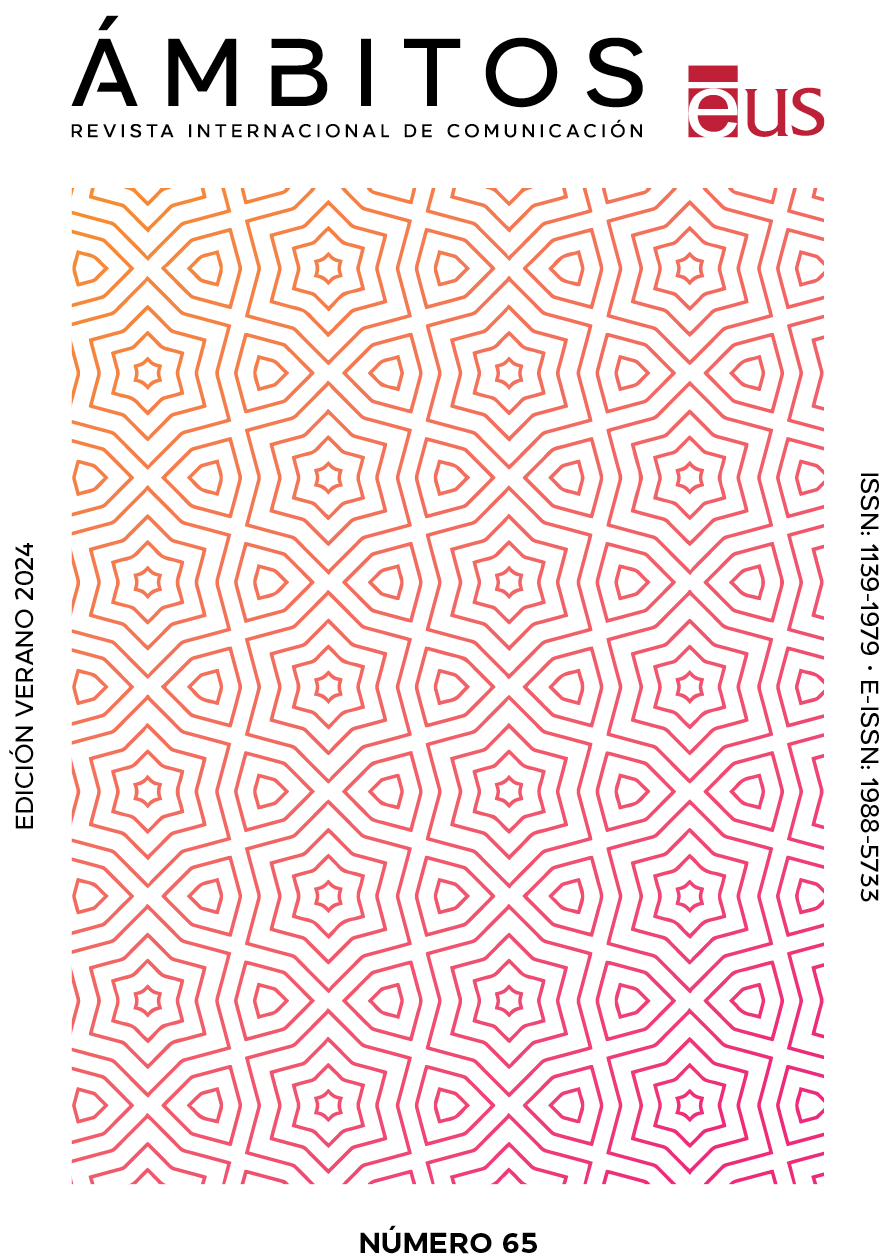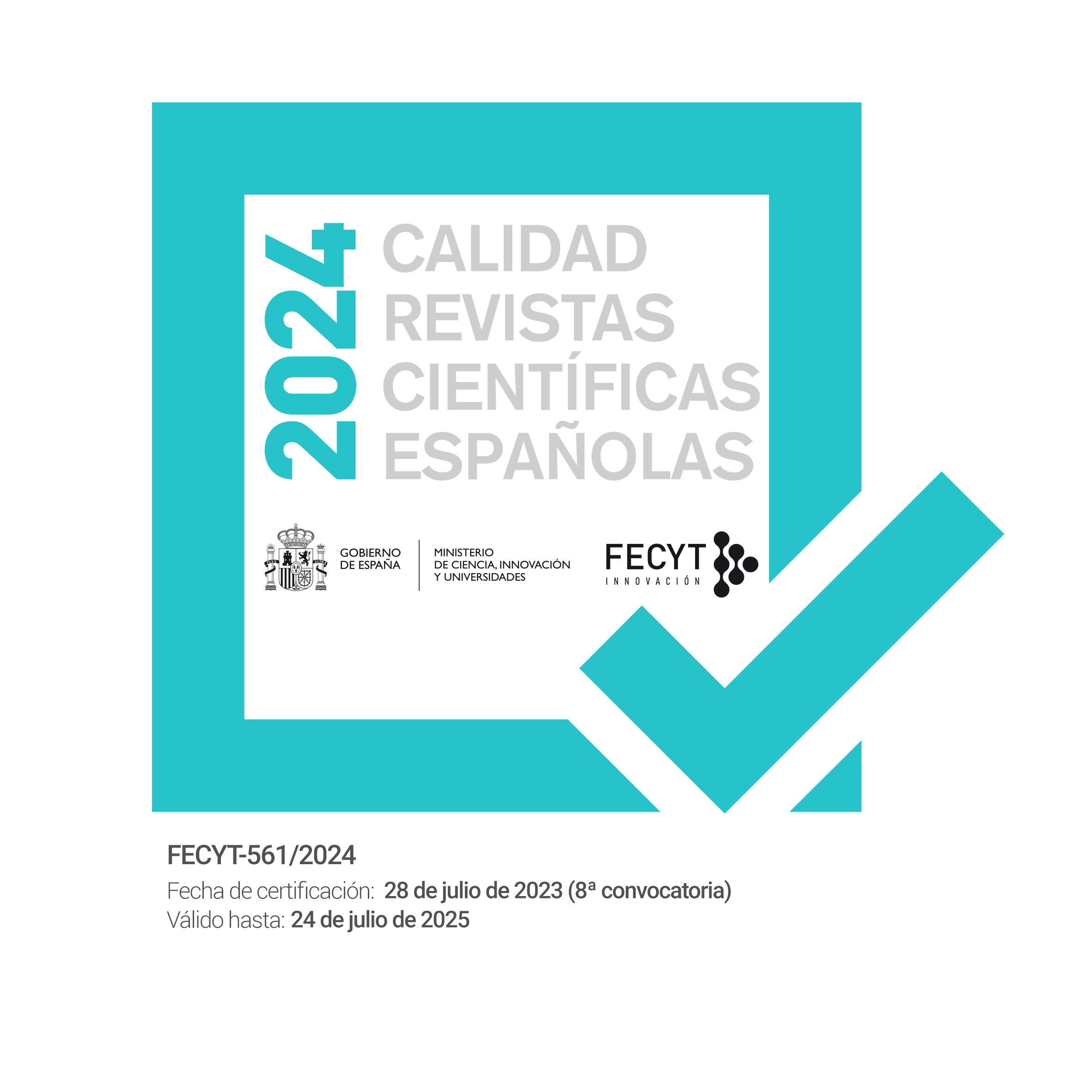Imagen y presencia de la mujer política en medios digitales regionales
DOI:
https://doi.org/10.12795/Ambitos.2024.i65.09Palabras clave:
mujer política, diarios digitales, instituciones regionales, campaña electoral, selección de la informaciónResumen
Este artículo estudia el grado de representación que alcanza la mujer política de Castilla y León en tres diarios regionales digitales: diariodeleon.es, eladelantado.com y elnortedecastilla.es durante las campañas electorales de 2011 y 2015. El objeto de estudio es identificar tres puntos importantes: detectar la presencia de la mujer política en las instituciones de la comunidad de Castilla y León, estudiar la representación de mujeres y hombres políticos en los diarios regionales y, por último, comprobar el tratamiento y selección de la información que los periodistas redactan en sus diferentes textos e imágenes. Como metodología se han empleado dos técnicas de análisis –cualitativa y cuantitativa– que conforman la creación de una base de datos a modo de muestra para su posterior análisis. Se ha delimitado la investigación a las campañas electorales que tienen lugar del 6 al 21 de mayo de 2011 y del 8 al 23 de mayo 2015. Se han observado dos campañas electorales para comprobar si existe una evolución positiva en la representación política de la mujer de la campaña electoral más antigua a la más reciente en los diarios digitales de Castilla y León. Se concluye que los medios digitales analizados otorgan el mismo tratamiento informativo a las personalidades políticas independientemente de que pertenezcan al sexo masculino o femenino. Como conclusión general se demuestra que entre 2011 y 2015 existe una evolución positiva tanto en la participación de la mujer en las instituciones políticas como en la representación de la mujer política en los medios regionales digitales.
Descargas
Citas
Astelarra, J. (1990). Participación política de las mujeres. CIS.
Cabrera, A., Sánchez Calero, Mª L., Vinuesa Tejero, Mª L., & Abejón Mendoza, P. (2013). De la representación residual de las mujeres en el parlamento portugués al debate parlamentario de la Ley de Paridad (2001): representación mediática de las diputadas en el debate parlamentario. Revista CIC Cuadernos de Información y Comunicación, (18), 205-221. https://doi.org/10.5209/REV_CIYC.2013.V18.41818
Cruzado, A., & Ortiz de Zarate, A. (2008). Feminismos e interculturalidad. ArCiBel Editores.
De Diego González, Á. (2008). Las mujeres de la Transición. Cortes Generales.
Escribano, J. J. G., & Balibrea, L. F. (1999). Mujeres, hombres y participación política. Reis: Revista Española de Investigaciones Sociológicas, (86), 307–329. https://doi.org/10.2307/40184154
García, A., Gómez– Escalonilla, G., Torregrosa, JF., Rodríguez, R., & Santín, M. (2006). Una aproximación a la representación y percepción de la mujer política [ponencia), IX Congreso Internacional Ibercom. Universidad de Sevilla.
González Encinar, J.J. (2002). Derechos y medios de comunicación. Hacia un cambio de paradigma. En M. Aragón Reyes, J. Jiménez Campo, J. J. Solozábal Echavarría y F. Murillo Ferrol. La democracia constitucional. Estudios en homenaje al profesor Francisco Rubio Llorente (pp. 593-606). Congreso de los Diputados.
La Moncloa, (s/f). https://www.lamoncloa.gob.es
Lemish, D., & Drob, G. (2002). All the time his wife: portrayals of first ladies in the Israeli press. Parliamentary Affairs, (55), 129-142. https://doi.org/10.1093/parlij/55.1.129
Norris, P. (2002). Campaign communications. En L. Lawrance, R. G. Niemi & P. Norris, eds. Comparing Democracies 2. New Challenges in the Study of Elections and Voting (pp. 127-147). Sage.
Palmer, B., & Simon, D. M. (2005). When Women Run Against Women: The Hidden Influence of Female Incumbents in Elections to the U.S. House of Representatives, 1956–2002. Politics & Gender, 1(01). https://doi.org/10.1017/S1743923X05050026
Venegas, M. (2017). Coeducar las Relaciones Afectivosexuales para Promover la Igualdad Sexual y de Género y la Justicia Social. Revista Internacional de Educación para la Justicia Social (RIEJS), 6(2), 13-28. https://doi.org/10.15366/riejs2017.6.2.001
Sánchez, ML, Vinuesa, ML, & Abejón, P. (2013). Las mujeres políticas en España y su proyección en los medios de comunicación. Razón y Palabra, (83). http://www.razonypalabra.org.mx/N/N82/V82/01_SanchezVinuesaAbejon_V82.pdf
Sodaro, M. J. (2010). Política y ciencia política. Una introducción. McGraw-Hill Interamericana.
Vinuesa, Mª. L., Abejón, P., & Sánchez, Mª L. (2011). Mujeres y política: un binomio con baja representación. Ámbitos. Revista Internacional de Comunicación, (20), 127-145. http://dx.doi.org/10.12795/Ambitos.2011.i20.07
Publicado
Cómo citar
Número
Sección
Licencia
Derechos de autor 2024 Cristina Álvarez García

Esta obra está bajo una licencia internacional Creative Commons Atribución-NoComercial-CompartirIgual 4.0.
Ámbitos. Revista Internacional de Comunicación es una revista de acceso abierto, lo que significa que todo su contenido está disponible gratuitamente para el usuario o su institución. Los usuarios pueden leer, descargar, copiar, distribuir, imprimir, buscar o enlazar con el texto completo de los artículos, o utilizarlos para cualquier otro fin lícito, sin solicitar permiso previo al editor o al autor. Esta definición de acceso abierto se ajusta a la Iniciativa de Acceso Abierto de Budapest (BOAI).

A menos que se indique lo contrario, todo el contenido de la edición electrónica se distribuye bajo una " licencia internacional Creative Commons Attribution-NonCommercial-ShareAlike 4.0 ". Puede consultar la versión informativa y el texto legal de la licencia aquí. Esto debe indicarse expresamente de esta manera cuando sea necesario.
En caso de aceptación del manuscrito, los autores ceden los derechos de la obra para su publicación a Ámbitos. Revista Internacional de Comunicación bajo el contrato de licencia Reconocimiento-NoComercial-CompartirIgual 4.0 Internacional (CC BY-NC-SA 4.0). Los autores conservan los derechos de autor y terceros están autorizados a copiar, distribuir y hacer uso de la obra, siempre que cumplan con los términos y condiciones establecidos en la licencia.
- Citar la autoría y la fuente original de publicación (revista, editorial y URL de la obra).
- No los utilice con fines comerciales.
- Si remezcla, transforma o crea a partir del material, debe publicar sus contribuciones bajo la misma licencia que el original.
Se puede encontrar más información en https://creativecommons.org/licenses/by-nc-sa/4.0/deed.es



















